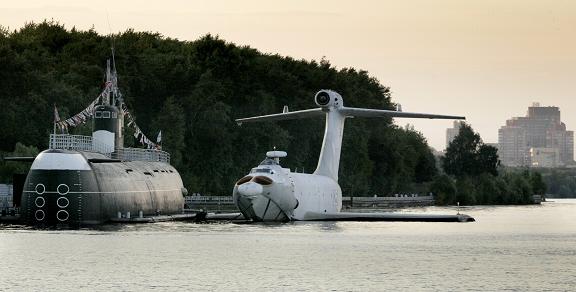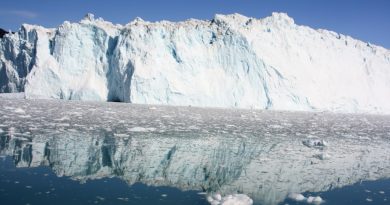Russia: Tenders issued to design Arctic ships and equipment
 Russia’s Ministry of Industry and Trade has issued tenders to construct new types of vessels and infrastructure for the Arctic. The tenders call for the following [1]:
Russia’s Ministry of Industry and Trade has issued tenders to construct new types of vessels and infrastructure for the Arctic. The tenders call for the following [1]:
•Light and heavy Arctic surface-effect ships: 458 million rubles/$15.7 million
•Ground effect vehicles for the Far North: 70 million rubles $2.4 million
•High-speed sea and river catamarans (“Alligators”): 25 million rubles/$857,000
•Floating Production Storage Offloading vessels (FPSOs): 40 million rubles/$1.37 million
This directive to advance Russia’s northern air and maritime capabilities is part of the Development of Civilian Marine Engineering program, which started in 2009 and will last until 2016.
With this program, Russia is attempting to revitalize the domestic shipbuilding industry to benefit both its military and civilian sectors, and particularly Arctic offshore oil development. Russia wants more equipment in the Arctic, and it wants it built at Russian ports – not abroad.
Industrial policy in the area of shipping is often a sensitive topic. When President Ronald Reagan ended the commercial shipbuilding subsidies in 1981, production moved to shipyards in places like South Korea, Japan, and China, where subsidies are still in effect, and the EU, where they were discontinued in 2000. Most of Russia’s civilian ships are imported, and even the military ships the country builds often take longer than normal to construct.
This results in the fleet receiving ships later than anticipated, making them become outdated more quickly, which Global Security describes in more detail. If Russia is to design more equipment at home, it will have to make sure that the actual development and construction process is made more efficient, too – a difficult task given the heavy hand of the Kremlin’s involvement.
Light and heavy Arctic surface-effect ships
By far, the majority of the tenders are being issued for the three- and ten-ton surface-effect ships. The heavy version will be able to carry up to thirty people and stand up to waves up to 2.5 meters high. They will also have cushions of pressurized air that allow the vehicles to overcome obstacles up to one meter high. Hovercraft, which are similar to surface-effect ships, have been used in Alaska for some time; a few years back, the Smithsonian had a small exhibit with a model AP.1-88 hovercraft that used to deliver mail to eight remote villages in the western portion of the state.
Monday, a company called Alaska Hovercraft, owned by Lynden, Inc., specializes in shipping in far-flung areas, like Alaska, western Canada, and Russia. The company leases and sells commercial-size hovercraft to move both people and cargo.
The Russian company Aerokhod produces the “Khivus-10,” described as a light amphibious air-cushion boat. Aerokhod’s head, Yuri Shamanin, told the Voice of Russia that compared to aircraft, surface-effect ships can spend more time in remote areas. He added, “Limited navigation in ice and the shallow depths on the [continental] shelf just eliminate the use of large vessels.” He believes that “surface effect ships have long proved their reliability in the Arctic.” Certainly, this is not the first time a government has attempted to develop such vessels for widespread use in the Arctic. In the 1970s, the U.S. Naval Ship Research and Development Center published a book entitled, “Research and Development of New Seal Materials for Surface Effect Ships and Arctic Surface Effect Vehicles.” The ships are noisy and can consume a lot of gas, though, so in some cases, small and maneuverable ground-effect vehicles might be more practical.
Ground effect vehicles (ekranoplans)
Ground effect vehicles (GEVs) were a specialty of the USSR. They can only fly as as high as their wings are wide. Despite this limitation, they have several advantages over planes. They are faster, can carry relatively heavier payloads, and fly at low altitudes where radars cannot see them. The USSR used GEVs to transport soldiers at 340 miles per hour, generally across the Caspian Sea. The first time the vehicle was spotted by American surveillance satellites, it was dubbed the “Caspian Sea Monster.” Soviet ekranoplans were huge, and much bigger than the variants that are used in Alaska for commercial purposes.
The website of Pacific Seaflight, an Alaskan company, shows that they at one point sought to pioneer the use of wing-in-ground effect planes as a type of passenger-ferry service in Alaska’s Inside Passage, where there are no roads between communities. This is a similar situation across much of the Arctic, where communities are scattered across wide distances. Since it doesn’t look like Pacific Seaflight’s plan ever took off, residents still have to rely on airplane flights or the Alaska Marine Highway System, which uses ferries to transport people. Russia is much larger than southeastern Alaska, of course, so ferry voyages would be somewhat impractical due to the length of time involved. Therefore, ground effect vehicles could have both military and commercial purposes in Russia.
High-speed sea and river catamarans, called “Alligators”
Catamarans have been used in the Arctic before. In 2009, a group of Russians sailed the Northern Sea Route on inflatable catamarans.
But the Kremlin is more interested in high-speed catamarans than inflatable ones. Such vehicles have been used by the Australian, American, and Indian navies. The U.S. is currently running the Joint High-Speed Vehicle Program, with 10 JHSV (fast catamaran) ships having been assigned to the Navy. The ships can move up to 35 knots and transports troops, equipment, and vehicles between theaters.
The Norwegian Navy also has six high-speed catamarans, called the Skjold Class Missile Fast Patrol Boats. They are small, and traveling up to speeds of 60 knots, they are also the fastest armed ships in the world. The Skjold ships carry a lot of weapons and are able to engage in combat at sea. Their air cushion catamaran design, which is based on technology used in surface effect ships, allows them to cut through waves more easily, as resistance is reduced. Additionally, the Skjold ships have covert operational capability, which, as Naval Technology points out, is useful given Norway’s topography. They can hide in the country’s many fjords and inlets while still surveilling the coastline. Though Russia’s coastline is different, these ships would still be useful for navigating along its lengthy shores.
Finally, the Royal Canadian Mounted Police also employ a catamaran in their fleet: the RCMP Nadon. In fact, this ship traveled the Northwest Passage in the summer of 2000
FPSO-class vessels
Floating Production Storage Offloading vessels (FPSOs) process and store hydrocarbons that have been extracted from offshore fields. The oil or gas are then be transferred to pipelines or ships and tankers, which take the resources to shore. FPSOs offer lots of flexibility in that they can moor in one place for a long time, but also sail to other sites. This is particularly beneficial in harsh operating environments like the Arctic, where the weather can quickly take a turn for the worse. If an oil field also ends up not producing a lot of hydrocarbons, the FPSO can simply move to another location.
Many FPSOs stay in the same place for years, if not decades, if a field is productive. In one study, 5 out of 6 Norwegian FPSOs planned to stay at least five to ten years longer than originally planned, due to the high productivity of the field and the vessels’ longevity. FPSOs vary widely in price depending on their capabilities. They can cost anywhere from $55-700 million, so the amount Russia is offering seems to be a small investment. Rigzone, which offers a good primer on FPSOs, states that these types of vessels have been used in places like the North Sea, the Mediterranean, offshore Brazil and West Africa, in the Pacific Ocean around Asia. None have been used in Russia before. Most of the country’s oil production still takes place onshore, so the government’s desire to improve its infrastructure and its willingness to consider allowing more private companies to get involved in offshore drilling demonstrates its commitment to opening up this frontier.
Russia’s first Arctic offshore drilling platform, Prirazlomnaya, was towed into place in the Pechora Sea in September 2011, and drilling is expected to begin this year. As Oil and Gas reports, the platform was made using a part of an oil platform that had operated in the North Sea from 1984-2004. But some see Russia as trying to cut corners by using outdated infrastructure. In the cutting-edge industry of Arctic offshore drilling, where safety concerns are supposed to be one of the top priorities, it is worrying that Russia would use an old platform as the foundation of its first venture.
Conclusion
Russia obviously wants to upgrade its aging Arctic infrastructure, but it is unclear from the case of the Prirazlomnaya platform whether it is willing to pay the price. The amounts it is offering in its tenders are low, too. But though in many areas, Russia has more equipment and infrastructure in the Arctic than countries like the U.S. or Canada, much of it is a relic from the Soviet Union, old, decaying, and poorly maintained. By far and away, Russia is still the leader in nuclear icebreakers, but as we saw, other countries like Norway have sleeker, faster boats which are useful in operating in the less-frozen areas of the Arctic. Revitalizing the domestic shipbuilding industry will also prove a hard task for Russia to accomplish alone. Inevitably, it will have to turn to other countries with more advanced experience to bring it up to speed. Whether the government will allow its shipbuilding and offshore oil industries to welcome foreign investors without too much red tape is the real question.
Results of the tenders will be announced on March 16.
News Sources
[1] http://www.i-mash.ru/news/nov_otrasl/20425-dlja-osvoenija-arktiki-rossii-nuzhny-novye-suda.html“Russia eyes new generation [of] Arctic ships,” Voice of Russia
“Russia to conquer the Arctic with air-cushioned ships,” Izvestia (in Russian)



